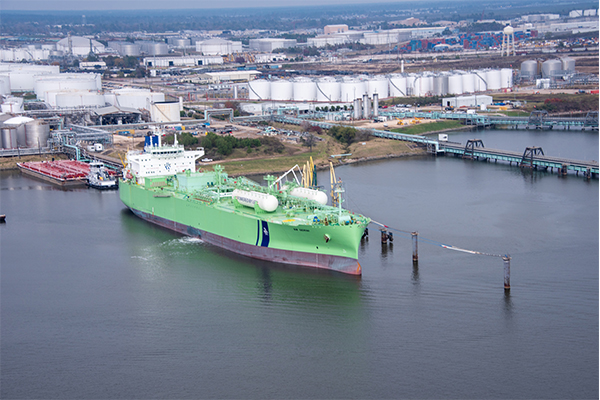Enterprise welcomes first vessel powered by LPG
The first vessel powered by LP gas loaded at the Enterprise Hydrocarbon Terminal on the Houston Ship Channel in December.

BW Gemini’s first voyage on LPG took it to the Enterprise Hydrocarbon Terminal on the Houston Ship Channel. Photo courtesy of BW LPG Pte Ltd.
BW LPG’s very large gas carrier (VLGC) BW Gemini, which had been retrofitted for dual-fuel capabilities, was loaded with 590,000 barrels of LPG, including cargo and fuel.
“Enterprise is proud to be part of this milestone achievement, which benefits both the supply and demand sides of the LPG value chain, provides environmental benefits and improves the lives of people around the world,” says A.J. “Jim” Teague, co-CEO of Enterprise’s general partner. “LPG-powered vessels provide another source for growing U.S. shale production and offer enhanced efficiencies and economics for ship owners and their customers by allowing VLGCs to refuel at the loading dock instead of making an additional stop at a bunkering facility. Enterprise is already the largest exporter of propane in the world, and is helping to raise the standard of living and improve the health and quality of life for developing nations around the globe.”
By providing the option for vessels to refuel with LPG, Enterprise is also helping shipping companies reduce their emissions in accordance with the new International Maritime Organization standards (IMO 2020), the company says.
On the back of BW Gemini’s successful retrofitting and first voyage, as well as the company’s belief in the future of LPG, BW LPG has committed an additional three VLGCs for retrofitting. This brings the total commitment to 15 vessels and a combined cost of about $130 million, the company says.
“We are taking the lead and advancing technology that will allow us to decarbonize and maximize the value of an asset with a 20-year lifespan as we prepare for a zero-carbon solution,” says Anders Onarheim, BW LPG CEO.
“Building new ships can provide the benefits of operating with LPG but comes at a heavy cost,” he adds. “Counting total emissions, a new ship represents about 70,000 tons of carbon dioxide in the materials and building process. Compared to 2,000 tons of carbon dioxide for retrofitting, the sustainability outcome is much better from retrofitting than from building new vessels.”
















